Shade Trees of the High Desert
I often get asked what the best shade trees are for our high desert climate. While I have my favorites, many trees are great for shade and can handle our climate with ease. There are pros and cons to each, and here I aim to explain them to make the decision easier. The trees that I’ll be comparing are: California Sycamore, Chilean Mesquite, Chinese Elm, Chinese Pistache, Fruitless Mulberry, Palo Verde, Raywood Ash, Silver Maple, Thornless Honeylocust, and Zelkova Serrata. For photos of the trees you can click on the names below to be taken to their dedicated page.
These are the categories that I’ll evaluate for each tree:
- Root Damage Potential
- Growth Rate
- Acclaimed Mature Tree Size
- Drought Tolerance
- Shape and Appearance
- Right Tree Right Place – Discussing Where To Plant

Description and Comments:
California Sycamore trees are great. They do really well in lawns as they prefer extra water if possible. They drop little seed balls that can annoy the average homeowner, but are great trees outside of that nuisance.
Root Damage Potential: Moderate
Shallow root systems are more common with decreased or sparse irrigation. Arbor Day Foundation recommends leaving 12′ of space between the trunk and any sidewalks and curbs. This is commonly disregarded and the damage tends to be minimal when planted as a street tree depending on the treatment of the tree. I wouldn’t plant these near a septic tank or immediately next to your driveway or the foundation of your home.
Growth Rate: Moderately Fast
24″-36″ or more per year. Good soil, regular irrigation, and fertilizer will help to ensure a fast growth rate.
Acclaimed Mature Tree Size: Height of 40′-100′ and Spread of 40′-70′
The higher end of these estimations is assuming ideal environment and care. Accounting for the average care and environmental situation of trees in the high desert the realistic mature tree size is closer to a height of 40′-70′ and a spread of 20′-40′
Drought Tolerance: Low to Moderate
While native to California, California Sycamore trees are not considered to be drought tolerant trees. Even when established, they need regular irrigation throughout the dry summer months. They may appear fine without additional irrigation, but lack of irrigation leads to a slow decline in the trees that usually results in some type of pest or disease being the ultimate “killer” of the tree.
Shape and Appearance: Pyramidal Shape
If left to grow in it’s natural form, California Sycamores grow in a pyramidal shape with an eventual rounding effect during maturation. Fall color is yellow and this tree has mottled bark that is unique to most other trees.
Right Tree Right Place: Large Open Area
Great places to plant these trees includes a lawn, large yard, or somewhere with regular irrigation. To avoid problems of varying degrees, it is recommended these trees are NOT planted in the following places:
- Under power or utility lines
- Within 10′ of your home
- Within 30′ of your septic tank
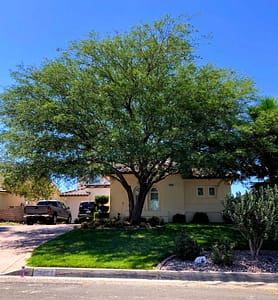
Description and Comments:
Most varieties of Chilean Mesquite are thornless, but hybridizing is very common in mesquites. Hybridized mesquites can still have a small amount of thorns.
These trees need to be pruned back a little bit each year for the first few years to encourage the root system to branch out and get a good hold in the ground. If the roots don’t branch out these trees can easily be blown over by our wonderful winds within the first few years.
Root Damage Potential: Low
Root damage potential is low, but this can be changed based on circumstances. If you plant these near a septic tank and give no additional irrigation it can search out water and potentially work its way into a septic tank. It is recommended to plant these 20′ or more away from a septic tank.
Growth Rate: Fast
36″ or more per year. These trees grow slower with limited irrigation. They will drop leaves in summer to compensate for limited irrigation, and this slows the growth rate. Regular irrigation and occasional fertilizer will help to ensure a fast growth rate.
Acclaimed Mature Tree Size: Height of 30′ and Spread of 30′
These trees grow to the stated size and our climate and soil does not impact the eventual size of these trees. Regular irrigation ensures this size and does so in less time.
Drought Tolerance: High
These trees have a very high tolerance of drought. The only tree with better drought tolerance is the Palo Verde. As stated above, regular irrigation speeds up the growth rate, and occasional watering during extended drought helps to ensure a healthier tree.
Shape and Appearance: Umbrella Shape
These trees for the shape of an umbrella. This provides a great wide shade canopy.
Right Tree Right Place: Full Sun
Great places to plant these trees includes a typical home landscape. To avoid problems of varying degrees, it is recommended these trees are NOT planted in the following places:
- Under power or utility lines
- Within 10′ of your home
- Within 20′ of your septic tank
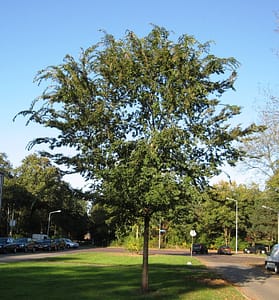
Description and Comments:
Chinese Elms are commonly mistaken for Siberian Elms which are a different type of elm with significantly more problems. Don’t let that deter you from these trees.
I commonly recommend this tree as the closest thing to a weeping willow that is recommended to plant in your landscape. It takes a while before it weeps, but is magnificent when it does.
Root Damage Potential: Moderate
Moderate root damage potential means to take care when choosing to plant these trees. Avoid major problem areas such as close to the house, right next to a driveway, or the septic tank and you’ll be fine.
Growth Rate: Fast
36″ or more per year. This refers to the vertical growth increases per year.
Acclaimed Mature Tree Size: Height of 40′-60′ and Spread of 50′-70′
These trees don’t reach their full size, but get close with average care and environmental conditions. They will more likely grow up to a height of 40′-50′ with a spread of 40′-50′.
Drought Tolerance: High
While it is tolerant of drought, it does not fair as well in extended drought. This means that a good soaking of the root zone once or twice during the summer will ensure that it doesn’t experience extended drought.
Shape and Appearance: Rounded or Umbrella Shape
These trees form the shape of an umbrella with weeping branches reminiscent of a weeping willow. The larger they get, the more round they tend to be.
Right Tree Right Place: Full Sun
Great places to plant these trees includes a typical home landscape, but requires a bit of distance from potential problems. To avoid problems of varying degrees, it is recommended these trees are NOT planted in the following places:
- Under power or utility lines
- Within 10′ of your home
- Within 30′ of your septic tank
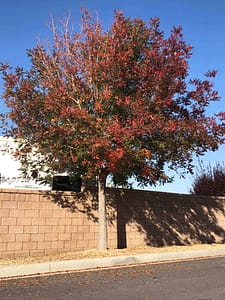
Description and Comments:
The leaves of these trees turn bright red in the fall and it is amazing. The fall color is the real attractor to this tree along with the low root damage potential.
If you plant a female tree you can get seeds that drop from the tree. While easily raked and picked up, if left onto of rocks it will find its way down and potentially sprout new trees.
Root Damage Potential: Low
Chinese Pistache trees are commonly used as a street tree. This includes planting them in small spaces or strips of planters near roads. This means that it makes a great tree to be planted closer to structures, driveways, and planters without having to worry about damage from the roots.
Growth Rate: Moderate
These grow around 24″ per year. Good soil, regular irrigation, and fertilizer will help to ensure a fast growth rate.
Acclaimed Mature Tree Size: Height of 25′-35′ and Spread of 25′-35′
These trees can handle a large amount of conditions that typically stunt other trees growth such as compacted and poor soil. Due to this the tree will reach the acclaimed mature tree sizes listed above.
Drought Tolerance: High
While the drought tolerance of this tree is high, it requires irrigation to become established like any other tree. Infrequent deep watering encourages future drought tolerance. Exposing the tree to drought early can slow down the growth rate.
Shape and Appearance: Rounded
These trees grow to a rounded shape and will continue that way if left to grow in it’s natural form.
Right Tree Right Place: Where Shade is Desired
Great places to plant these trees includes almost any residental landscape. To avoid problems of varying degrees, it is recommended these trees are NOT planted in the following places:
- Within 10′ of a power or utility line
- Within 10′ of your home
- Within 15′ of your septic tank
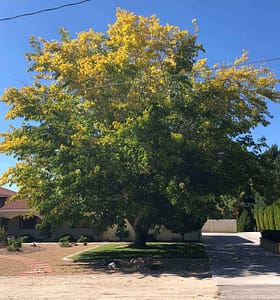
Description and Comments:
I could write a dissertation about Fruitless Mulberry trees here, but I’ll keep it brief. As the most commonly planted tree in the high desert, it is also the most commonly mistreated. They’re great trees if you don’t prune them every year, and can live up to 100 years if cared for well. Most of these trees live 25 years due to topping and lack of care. One of the best shade trees, but the root damage is often overlooked and they become problems when planted in the wrong place and not taken care of.
Fantastic climbing tree.
Requires staking the first few years due to them being top heavy.
Also has a ton of pollen which causes allergy problems for those sensitive to pollen.
Root Damage Potential: High
The high damage potential of the roots of Fruitless Mulberry trees is often overlooked when purchasing and planting one of these trees. Due to the lack of irrigation these trees get they frequently cause issues with their roots as they search out water.
Growth Rate: Fast
36″ or more per year. This refers to the vertical growth increases per year.
Acclaimed Mature Tree Size: Height of 20′-35′ and Spread of 30′-45′
These trees can easily reach this size due to their adaptability to adverse conditions. This is also frequently disregarded and planted in areas where a smaller tree is desired. When this happens and they reach a larger size people prune them yearly to control the size. This causes an unnecessary cost in yearly maintenance of the tree. This is harmful to the tree and will eventually cause the tree to succumb to pests or diseases.
Drought Tolerance: Moderate to High
While very drought tolerant, caution should be taken when deciding to not irrigate these trees. If they are relatively close to a source of water (well, water main line, near the house, etc.) and you do not irrigate them semi-regularly this encourages the roots to go find water. Taking that knowledge and the fact that a study found that tree roots are “able to locate a water source by sensing the vibrations generated by water moving inside pipes…” helps us understand the danger of not irrigating them regularly. If it is 50’+ from significant problems, then you can feel a bit better about not irrigating regularly.
As with other trees, extended drought opens these trees up to be more susceptible to diseases and pests.
Shape and Appearance: Rounded or Umbrella Shape
These trees tend to have a rounded shape that starts off umbrella shaped and rounds as it matures.
Right Tree Right Place: Far From Structures and Water Sources
Great places to plant these trees includes parks, large ranches, and properties with a large amount of space to accommodate the size of the tree and the invasiveness of the roots. To avoid problems of varying degrees, it is recommended these trees are NOT planted in the following places:
- Within 15′ of a power or utility line
- Within 25′ of your home
- Within 35′ of your septic tank

Description and Comments:
These are great trees and perfect for those wanting xeriscaping, drought tolerant landscaping, or very low maintenance trees. One down side is that the leaves drop and can be hard to get out of rocks unless you use a leaf blower.
Beautiful yellow flowers from spring through summer.
Thorns accompany the more commonly available Mexican Palo Verde.
Root Damage Potential: Low
Roots of Palo Verde trees are deep rooted and are not prone to cause problems.
Growth Rate: Moderately Fast
24″-36″ or more per year. This refers to the vertical growth increases per year.
Acclaimed Mature Tree Size: Height of 15′-20′ and Spread of 20′-25′
Palo Verde trees typically reach this size as our climate and conditions are similar to the native environment of Palo Verde trees.
Drought Tolerance: Very High
Palo Verde trees are extremely drought tolerant. After a two or three years of establishment from a nursery container, you may not need to irrigate Palo Verde trees. To encourage such drought tolerance you should water infrequently and deeply early on to promote root growth to follow. As mentioned above, removing irrigation may dramatically decrease the growth rate of your tree.
Shape and Appearance: Vase or Umbrella Shape
These trees form the shape of an umbrella or vase as they grow.
Right Tree Right Place: Full Sun
Great places to plant these trees includes a typical home landscape. To avoid problems of varying degrees, it is recommended these trees are NOT planted in the following places:
- Within 5′ of a power or utility line
- Within 7′ of your home
- Within 15′ of your septic tank
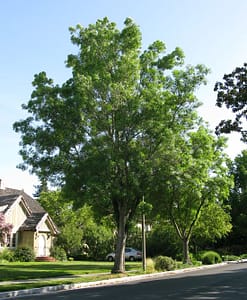
Description and Comments:
These trees have an amazing natural growth form, and pruning should be done to either thin out branches or to raise the height of the crown by removing the lower limbs only.
Fantastic fall color with a wine red to purple color that almost nothing else gives.
Root Damage Potential: Moderate
Root damage potential is moderate which increases the distance that these should be away from significant structures or concrete.
Growth Rate: Moderate
24″ or more per year. This refers to the vertical growth increases per year.
Acclaimed Mature Tree Size: Height of 40′-50′ and Spread of 20′-30′
While I’m not sure if I’ve seen a Raywood Ash tree that is 50′ tall, I have seen one that is 40′ tall. These trees are commercially grown as a residential landscape tree, and the mature tree size estimate reflects that even in our climate.
Drought Tolerance: Low
These trees were at one point marketed as drought tolerant, but recent findings have shown that drought in Raywood Ash trees increases the chance of dieback of the branches from Botryosphaeria stevensii, a secondary pathogen that affects stressed trees. Regular irrigation is encouraged even with mature trees.
Shape and Appearance: Oval or Rounded Shape
These trees form an oval shape in youth that typically spreads out as the tree grows and matures.
Right Tree Right Place: Full Sun
Great places to plant these trees includes a typical home landscape, but requires a bit of distance from potential problems. To avoid problems of varying degrees, it is recommended these trees are NOT planted in the following places:
- Under power or utility lines
- Within 10′ of your home
- Within 30′ of your septic tank
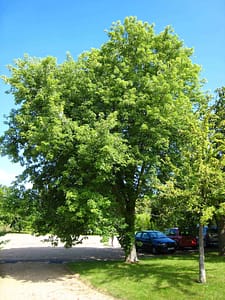
Description and Comments:
These trees are mostly a specialized tree. They don’t belong all over the high desert, and only really thrive in certain places. They don’t like the hot wind (ya know, the stuff we have every day) so if they can be sheltered from the wind, that would be ideal. Planting them outside of a lawn would require that they be watered frequently and heavily mulched, even once established.
These trees are usually labelled as a tree with weak wood due to such a fast growth rate. This can be dealt with by pruning out weak branches. You want to keep branches with a wide angle from the trunk. If it has an acute angle from the trunk it will have a higher tendency to break in the wind. If properly pruned, this potential problem can be eliminated.
There are Silver Maple hybrids that are better suited for residential planting such as Autumn Fantasy Maples that are similar in size, growth rate, root damage, drought tolerance, and shape.
Root Damage Potential: Moderate
Root damage of Silver Maples is likely to happen when irrigation isn’t sufficient, or if planted too close to sidewalks and foundations. The roots of Silver Maple trees are very shallow, so as they grow the roots can surface as their diameter increases. This is more common the closer you get to the trunk.
Growth Rate: Fast
36″ or more per year. This refers to the vertical growth increases per year. These are very fast growers, especially when give proper care.
Acclaimed Mature Tree Size: Height of 40′-100′ and Spread of 50′
These trees don’t reach their full size due to our climate and environment. They will more likely grow up to a height of 30′-50′ with a spread of 40′-50′.
Drought Tolerance: Low
These trees love water and need it to thrive here in our climate. The wind and heat cause Silver Maple trees to lose a lot of water through transpiration, and it needs a constant availability of moisture in the root zone to replenish the lost water. Best to place in a regularly irrigated lawn or garden.
The shallow root system also plays a part in the need for regular irrigation to keep the surface soil moist.
Shape and Appearance: Rounded or Oval Shape
These trees form a large rounded canopy that give fantastic shade.
Right Tree Right Place: High Water Area with Space
Great places to plant these trees includes residential homes with space and regular irrigation., and requires a bit of distance from potential problems. To avoid problems of varying degrees, it is recommended these trees are NOT planted in the following places:
- Near power or utility lines
- Within 30′ of your home
- Within 40′ of your septic tank
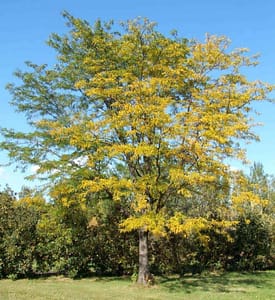
Description and Comments:
These trees are great for planting in lawns that can not handle shade well. These trees give dappled shade and have a great form.
They have seed pods that people tend to dislike.
These trees fix nitrogen in the soil which helps to make the surrounding soil more fertile which requires less fertilizing.
Root Damage Potential: Moderate
Moderate root damage means this needs to stay away from important structures and sidewalks, but can be ok if given proper care.
Growth Rate: Fast
36″ or more per year. This refers to the vertical growth increases per year.
Acclaimed Mature Tree Size: Height of 35′-70′ and Spread of 25′-35′.
These trees don’t reach their full size due to our climate and environment. They may reach heights up to 25′-40′ with a spread up to 25′.
Drought Tolerance: Moderate
Moderate drought tolerance shows the need for occasional watering during the hot summer months or a prolonged drought.
Shape and Appearance: Umbrella or Oval Shape
These trees form a large rounded canopy that give fantastic shade.
Right Tree Right Place: High Water Area with Space
Great places to plant these trees includes residential homes and requires a bit of distance from potential problems. To avoid problems of varying degrees, it is recommended these trees are NOT planted in the following places:
- Near power or utility lines
- Within 10′ of your home
- Within 30′ of your septic tank
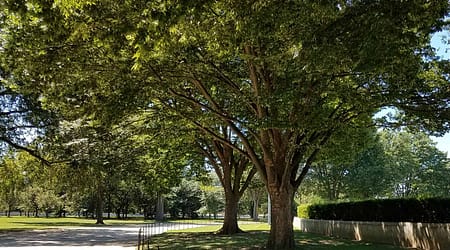
Description and Comments:
I feel that these trees have the potential to be the best shade trees out of the bunch. The issue is that I haven’t seen many planted that are cared for properly. The ones I have seen properly cared for have amazing canopies.
These trees require pruning in the first few years to get good branching and structure.
The perfect yellow fall color isn’t likely to happen so well here with how our fall seems to last a week.
Root Damage Potential: Moderate
Moderate root damage means this needs to stay away from important structures, but can be ok if given proper care.
Growth Rate: Moderately Fast
24″-36″ per year. This refers to the vertical growth increases per year.
Acclaimed Mature Tree Size: Height of 50′-65′ and Spread of 50′-65′
These trees likely won’t reach their full size due to our climate and environment. They will more likely grow up to a height of 30′-50′ with a spread of 35′-45′.
Drought Tolerance: Moderate
Once established these trees are moderately drought tolerant. Occasional watering during drought is encouraged to keep the tree healthy.
Shape and Appearance: Rounded or Umbrella Shape
These trees form a wide rounded canopy that give fantastic shade.
Right Tree Right Place: Moderate Water Area with Space
Great places to plant these trees includes residential homes with space, and requires a bit of distance from potential problems. To avoid problems of varying degrees, it is recommended these trees are NOT planted in the following places:
- Near power or utility lines
- Within 20′ of your home
- Within 30′ of your septic tank
